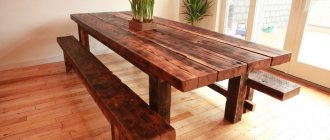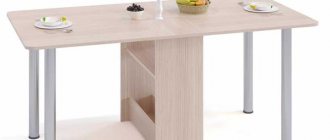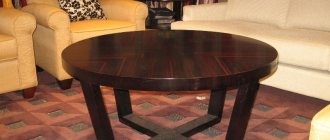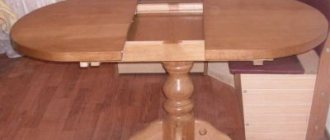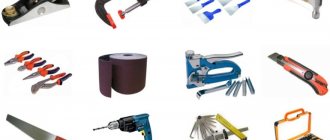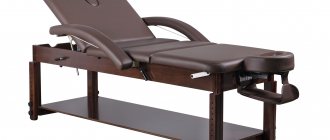When renovating or building, making furniture, and in other situations that require processing lumber, you may need a circular saw. Craftsmen who work with wood note that a sawing table is much more convenient and safer to use compared to a hand saw. Moreover, the accuracy of performing actions is much higher. You can make such a machine with your own hands - it is often more profitable and faster. In addition, a self-made design will more accurately meet the requirements of the master.
Design Features
Structurally, a homemade sawing table looks quite simple. The machine consists of a supporting frame for mounting the motor, a transmission unit and a work table with a slot for the cutting disk. The design is equipped with stops for guiding the workpiece and a protective screen that prevents chips from entering and also increases work safety.
Mandatory requirements for a sawing table:
- rigid, stable design;
- smooth surface of the tabletop;
- secure disk mounting;
- fencing protecting the operator of the machine (table);
- easy access to the control device (start and stop buttons).
The equipment must be installed on a frame supported not on solid sheets, but on legs. This improves ease of use, although it makes the saw table less stable. To increase durability, the frame can be made of metal or reinforced with metal elements. Safety is ensured not only by the protective screen, but also by securing the disk from the bottom (inner) side. Additional requirements depend on the specifics of the work - auxiliary elements help to process parts more accurately, saw longer boards, as well as thick logs.
By making a saw table with your own hands, you can get a number of advantages - from reduced costs to the ability to change the design as the master needs it. If desired, you can replace some of the parts with more economical ones, or use materials left over from repairs or construction. The only disadvantage of a circular saw independently fixed to the machine is a decrease in the accuracy of workpiece positioning. But this moment still largely depends on the skill of the performer himself.
Rigid, stable construction
Smooth countertop surface
Secure disk mounting
Guard protecting the operator of the machine (table)
Do-it-yourself circular: how to properly assemble a functional device
During the construction of a new house, when wood material is used in large quantities, a homemade circular saw will not be enough. And such a device will require more functionality. But when performing minor repairs, a homemade homemade circular saw becomes an indispensable technical assistant. We will tell you how to make a circular machine with your own hands in this article.
Stationary circular saw: popular models (read more)
A DIY circular saw allows you to carry out safe work and speed up the construction process.
Quite often, the dimensions of wooden elements are determined directly during the work. The ability to independently provide the process with the necessary materials significantly saves money and time. And often the quality of wooden blanks is guaranteed to be higher.
Using a homemade homemade circular saw, you can cut boards into bars, make planks, slats, trim blanks, saw slabs of wood materials into fragments of the required sizes.
Using a homemade circular saw, you can make such types of furniture as a table, shelf, rack. A similar stationary home tool is applicable when creating wooden sports equipment, making containers, etc.
When installing a disk with certain technical characteristics on a sawing machine, the mechanism can be used as a circular saw for metal. It is allowed to saw soft aluminum and sheets of other types of metal, the thickness of which does not exceed 2 mm. When working with thicker material, the mechanism will overheat, triggering an automatic shutdown.
For harvesting firewood and simply cutting pieces of wood, a firmly fixed table with a slot for a saw is enough.
Materials
When assembling a cutting table from chipboard with your own hands, you should maintain an optimal balance between functionality, safety, time and money. This can be achieved by selecting parts and materials with the necessary parameters. It is possible to reduce costs by using old parts of other structures - furniture, frames of wooden houses and outbuildings.
Tabletop
The main requirements for a saw table are resistance to heavy loads, shocks and vibration. The tabletop must be smooth enough to move and not bend under a weight of 50 kg or more. Suitable options might be:
- Metal (steel or duralumin) 3–5 mm thick. The advantages of metal countertops are high strength, almost unlimited service life, the disadvantages are heavy weight, decent cost.
- Laminated chipboard or moisture-resistant plywood with a thickness of at least 2 cm. The cost of this option will be the most profitable, but the strength is noticeably reduced.
- Textolite 15–20 mm thick. The material is more durable than plywood, but inferior to metal. In terms of cost, textolite countertops are also between metal and plywood sheets.
Plastic, chipboard or OSB are not recommended as countertop materials. A structure made from this raw material will be unstable to vibration from the saw. It is possible to make a table entirely from natural wood, but it is too expensive.
You can reduce costs while increasing strength by using combinations of materials—for example, thick plywood covered with sheet metal.
Metal
laminated chipboard
Textolite
bed
At the base of the table for sawing boards there can be wooden beams, secured under the lid to increase rigidity. Elements with a cross-section of at least 5 x 5 cm are placed at a distance of 50–90 mm from the edge of the tabletop. For the sawing table, it is recommended to choose bars made of hard wood - beech, hornbeam, oak. The advantages of wood are low cost, easy installation using self-tapping screws. Disadvantages - less strength and service life, high probability of fire.
The upper part of the table frame for cutting chipboard and other materials is often made by hand from the same sheets that were chosen for the table top. For the legs of a wooden structure, it is recommended to use timber, securing it with metal corners. The pros and cons of wooden supports are similar to the features of a frame made of the same material.
The basis of the table for cutting and sawing boards can be metal. Stability increases when choosing metal corners or channels with sides of 25–50 mm. To save money, they are purchased at scrap metal collection points or replaced with profile pipes. The frame parts are connected by welding. The use of bolted connections is not recommended due to the possibility of loosening due to vibration. The reasons for choosing a metal frame are maximum strength, reliability, and easy maintenance. Disadvantages: high cost, need to use a welding machine.
Metal
Wooden beams
Plywood
laminated chipboard
How to make a table for a circular saw
The content of the article
How to make a table for a circular saw Materials and tools Measurements and drawings Important points when working Do-it-yourself table for a circular saw: step by step
Creating a table consists of several stages:
Creating a project plan. You need to measure the space and choose the appropriate size of the structure. Purchase of materials. In the same step, the required saw is selected. Step-by-step assembly of the structure. Everything is done according to the drawings made.
Materials and tools
We will need the following materials and tools:
Sheet of particle board or plywood, 20 mm thick. Tool with disc-blade. 5x5 cm block for creating legs. The cross-section may be smaller if you plan to create a low-power saw. Varnish or primer. Solutions for protecting wood from water. Wood glue. Self-tapping screws. Drill and set of drills. Screwdriver. Jigsaw. Machine for milling work. Clamps. Tape measure and marker for marking. Plane. Sandpaper.
Reference! Also, we must not forget that a circular saw is equipment that runs on electricity. That is, we need a power source into which it will be connected.
Measurements and drawings
The work begins with the creation of design drawings. This step measures the width and length of the table that is being created. The average value is 120 cm wide and 120 cm long. The following materials are ideal for creating the base:
We recommend: How to make a wooden carpentry and metal workbench with your own hands according to the drawings: we are considering the issue
Plywood. Chipboard. OSB. MDF. Chipboard.
We are not considering a metal base, since the material is more expensive and the weight of the structure will increase several times. Of all materials, plastic is considered the worst and is not recommended by experts.
Before starting assembly, all wooden elements must be treated with solutions that protect against moisture and rot. After the material has dried, you can begin work.
Attention! It often happens that due to improper installation of the saw, which is installed under the tabletop, the table is overhanging on one side. The blade must be installed in the center of the table.
Important points when working
There are some safety requirements. They will help you avoid injury in the workplace. The requirements are as follows:
Before turning on the saw, you need to check the reliability of the clamps. If necessary, tighten the fasteners. Very often, the cause of injury is a large number of unnecessary things at the place of work. It is necessary to check the correct operation and fastening of all parts of the system. If there is a problem somewhere, it needs to be fixed immediately. Do not keep the material close to the place that is being cut. This is dangerous because knots and shavings can get on exposed parts of the body, as well as in the eyes. Therefore, while working, be sure to wear glasses and clothes with sleeves.
Selection of dimensions
It is worth choosing the size of the sawing table depending on the square footage of the workshop. The small area of the room allows you to use a tabletop of 50 x 50 cm. Making the sawing table smaller does not make sense - it will be difficult to use it when processing long workpieces. The universal size, ensuring convenient sawing of laminated chipboards, is 80 x 80 cm.
The maximum recommended dimensions of the sawing machine are 120 x 120 cm.
To comply with safety requirements, it is recommended to place the saw in the middle of the tabletop at a distance of at least 25 cm from the edge - it is this indicator that leads to the minimum width of 500 mm. The location of the saw blade also depends on how it will be used. There are three types of design:
- for longitudinal sawing;
- for cross cutting;
- universal.
The depth and location of the disk installation depend on the workpieces processed on the machine. For boards and plywood, it should protrude above the tabletop by 50-80 mm, for logs - by 110-125 mm. The height of the upper part of the frame made of sheets of plywood or chipboard can be in the range of 35–40 cm. If you make the frame only from timber, this parameter depends on the cross-section. The remaining part of the structure consists of wooden legs, the size of which craftsmen usually choose to suit their height. The overall height of the sawing table is about 1.0–1.1 m, but can be reduced to 900 mm.
How to make a device with your own hands
The cutting device is made for a specific model of power tool. On your circular saw, measure the distance from the engine to the bottom plane of the sole and subtract 5 mm. The result obtained is the height of the guide stop.
Removing the required dimensions of the circular saw.
Prepare a plywood base with right angles and wooden slats with parallel edges according to the dimensions.
Blanks for assembling a device for cross-cutting with a circular saw.
Measure the distance from the cutting blade to the edge of the sole.
Add an allowance of 6–10 mm and install a guide rail at this distance from the right end of the plywood. Secure the plank with countersunk screws, ensuring its strictly perpendicular position.
Screw the stop block on the back side and fix the device on the workbench.
Cut the plywood to the final width with a circular saw, creating a reference edge for precise positioning of the jig along the markings.
Draw a template for the cam clamp cam on paper.
Drawing of an eccentric clamp.
Mark the piece on 10mm plywood and use an awl to mark the center of the drill hole for the bolt.
Cut the workpiece with a jigsaw.
Make a washer with a diameter of 50 mm from the same plywood using a ballerina extendable wood drill.
Sand the workpieces and select an M6 or M8 furniture bolt with a mustache (or with a square headrest), a handwheel nut, a washer and a bushing. The latter can be made from a tube of suitable diameter. The length of the sleeve is the total thickness of the base, lever and plywood washer.
Ready-made plywood eccentric.
Make holes in the base with a drill according to the diameter of the bushing, which serve to rearrange the eccentric clamp according to the width of the board being cut.
Hole drilling diagram.
Assemble the eccentric mechanism: insert a bolt with a sleeve on top, and install a wooden washer, the cam itself and a steel washer from below. Tighten the parts with a nut.
Stick a strip of sandpaper on the inside of the stop to prevent slipping when the eccentric is locked, which can happen when the device is fastened to a smoothly planed workpiece.
The clamping system of this device has a stroke that ensures fastening on boards with a spread of approximately 10 mm in width. If you need to cut or trim pieces of a different size, simply place a wooden block in front of the stop beam.
An example of using a device for cross-cutting a board of smaller width with a hand-held circular saw.
If desired, the potential of the considered device can be expanded by adding a cutting angle of 45°. To do this, you will need to slightly increase the dimensions of the support platform and install a second thrust block at a given angle.
Create a drawing
The first stage of creating a machine for processing wood is drawings of a sawing table. You don’t have to compile them by choosing the appropriate option on thematic sites or forums. But it’s better to make at least the simplest diagram yourself, taking into account the available materials and the selected sizes.
The drawing notes all the nuances that will be needed to prepare the materials, indicate the mounting locations for the supports and their angles of inclination if the table legs are not perpendicular to the table top. In the figure it is also worth noting the place for attaching the unit to turn the saw on and off. When drawing up a diagram yourself, maintaining scale and exact proportions is not necessary. The main thing is to correctly indicate the dimensions of all future parts for the sawing machine.
Drawing and dimensions
Before you start working, it is recommended to make a drawing of the product. On it, indicate all dimensions, materials of manufacture and other important information. You can make a high-quality drawing of any piece of furniture using special computer programs .
When making a drawing of the table, be sure to consider the size of the circular saw. Each brand of tool will have a specific size.
If during the work process you like to leave materials on the table, then the dimensions of the tabletop should be at least 120 by 120 cm .
Manufacturing stages
Before assembling the machine for cutting boards, logs and blanks, you should prepare all the necessary materials and tools. To work you will need:
- moisture-resistant plywood;
- sheet material suitable for making the body;
- elements for the body and legs (bars 40 by 40 mm).
Fastening will be done with self-tapping screws using a screwdriver. All necessary parts are cut with a jigsaw. A saw with a disk of suitable diameter is also prepared.
Algorithm for creating a table:
- Sawing all parts into pieces with the required dimensions.
- Marking the mounting areas for the saw and legs on the table top.
- Making a case, which is usually a rectangular box without a lid or bottom.
- Installation of countertops.
- Cutting a hole that should be 5–10 mm longer and 4–6 mm wider than the disc.
If you cut the material at a certain angle, the resulting slot should resemble a trapezoid (inverted) in shape. For smooth sawing, a regular hole is made. Before cutting out the groove, you should apply a saw and adjust the marks.
Sawing all parts into pieces with the required dimensions
Marking the mounting areas for the saw and legs on the tabletop
Case manufacturing
Installing the countertop and cutting the hole
Preparing to install the saw
Making a crosscut from a circular saw with your own hands
Laying a wooden floor, replacing platbands, covering the facade with plank, clapboard, and creating landscape design elements require a dimensional board. The process of preparing such a board is called trimming. That is, the ends of the material are cut off in order to obtain the desired size of the workpiece and make the cuts aesthetically pleasing.
Do-it-yourself trimming makes work faster and more economical.
To make a crosscut from a manual circular saw with your own hands, you will need available materials and used tools.
The standard characteristics that a future trim should have are:
- maximum cutting length – 350 mm;
- optimal engine speed – 4500 rpm;
- light weight.
The upper part of the power tool is attached to the kingpin using a large bearing - 150 mm (it is not difficult to purchase on the market.) Ears are attached to the outside of the bearing. They are used to fasten the tool to the surface of the frame using M6 screws.
The main devices for making a circular saw with your own hands are car shock absorbers (they are convenient to use as a broach), a soft start button and additional protection that is attached to the power tool and the bed.
The upper part of the crosscut is attached to the kingpin using a bearing.
Note! Before assembling the structure, the shock absorbers must be disassembled, the oil drained and air holes made.
The advantages of a homemade miter saw include the following:
- The design is easy to disassemble, and the power tool can be used for its intended purpose.
- Low cost. Without taking into account the price of the instrument (used), the costs will be no more than 500 rubles.
Among the significant disadvantages, it is worth highlighting the high noise level. It is almost impossible to eliminate this drawback. In addition, it is necessary to make a test cut (selecting and fixing the draft) to ensure good quality of subsequent work.
How to install the saw correctly
The next step is to properly position the saw on the top surface of the saw table. To do this, the contractor must perform the following actions:
- Install the tool so that its working part fits into the pre-prepared groove.
- Mark the locations for the M8 plowshare bolts with countersunk heads (they will be used to secure the saw blade).
- Drill the plywood from the top to make equal holes with a diameter of about 8 mm.
- Make a countersink to countersink the bolt heads.
- Carefully install the metal saw blade and carefully tighten the bolts from the bottom using nuts and lock washers.
The work of making a machine requires great concentration and concentration. The slightest mistake can lead to having to start all over again.
After securing the structure to the table, you need to install a block to turn the circular saw motor on and off. A hole is cut in the housing, the switch is secured with bolts and universal glue. There should be two separate cables coming from the unit. One to the instrument, the other to the nearest electrical outlet.
When assembling such a unit yourself, it is worth taking into account the performance of the motor, as well as the maximum power of the electric motor. In this case, experts advise choosing a motor whose power does not exceed 1000–1200 W, otherwise operation may be unsafe. And a more powerful saw means a heavier and more stable table.
Install the tool so that its working part fits into the pre-prepared groove
Mark the locations for the M8 countersunk plowshare bolts
Install the metal saw blade and carefully tighten the bolts from below
Install a block to turn the circular saw motor on and off
Do-it-yourself circular: safety of use
If you take into account how much a circular saw costs (from 16,000 rubles - the most modest model), and compare the price with the costs of making it yourself (this is 60-90% less), then the difference is significant. But no savings will be justified if the safety of work is not ensured.
Before starting to work on the circular saw, be sure to wear goggles and gloves.
In order to avoid traumatic situations, you should adhere to the following recommendations:
- do not use wood with metal inclusions (nails, angles, bolts, etc.) as raw materials;
- cutting boards larger than 200 cm must be done by two people;
- When using a circular saw, you should not make sudden movements;
- Before starting work, be sure to wear goggles and gloves;
- Wood waste should be removed from the surface of the circular saw, as it can cause a short circuit.
It is strictly forbidden to work on a homemade circular saw:
- if the guiding device is not made;
- no casing;
- there are no finger guards;
- the riving knife is higher than the saw blade.
To avoid hazardous situations when working with a circular saw, you should adhere to safety precautions.
A good tool allows you to enjoy your work. And the result pleases with a high level of quality. Making a tool with your own hands will allow you to obtain the desired parameters and necessary performance characteristics. You cannot limit yourself to superficial knowledge in any type of activity, especially in a technical area. You should take on the task of assembling a circular saw yourself only after thorough theoretical preparation and a full understanding of the practical part of the process.
Machine and device for sharpening drills: how to make it yourself (read more)
Making stops
The last stage of making a sawing table with your own hands is installing stops. A standard part of most circular saws is a rip guide. Traditionally, the stop is made from an aluminum cornice or a wooden block. Its size is chosen so that the part runs across the entire table - parallel to the saw and from edge to edge.
Cross stops are also often used on sawing tables. They are used to cut parts at an angle of 90 degrees and trim boards. To make a stop, follow these steps:
- Prepare an ordinary plywood sheet 1 cm thick.
- Secure a block at least 2 cm high to it.
- Attach a second rail perpendicular to the first on the bottom side of the base.
- Cut off excess base.
The transverse stops are attached to the workpieces using clamps or fastening devices made from wooden washers. Such homemade clamps provide fastening of guides to parts of almost any width. If you fix the block on the underside of the base at an angle of 45 degrees, you get a corner stop. After all work is completed, the surface of the circular table can be treated with a grinding machine and coated with a layer of protective varnish. This will protect it from various mechanical damage, and in general will extend its service life.
Perhaps such a table does not look as attractive in appearance as a factory one. However, from a technical point of view, it is in no way inferior to it, so even a novice carpenter can safely take on its manufacture.
Prepare parts for the longitudinal stop
Assemble mounting brackets
Place the bar on the table
Clamp the crosscut pieces together
Attach the cross supports using clamps
Cross stop is ready
Finishing work
The final touch will be the improvement of your homemade table. An obligatory step in this procedure will be coating the surface with varnish of the circular table. First, sand the surface with sandpaper until the materials are smooth. If desired, you can tint the table. Next, we take the varnish and, using a cotton sponge and gauze, apply the varnish to all surfaces of the circular table, and especially carefully to the tabletop.
This will ensure that the surface is resistant to wear and tear and will dull the release of natural odors from the table parts. It is equally important that after processing and varnishing, the surface will become as smooth and pleasant as possible. This will ensure a comfortable workflow and keep your hands safe from painful rolling pins. In addition, you can paint the entire table in your favorite color, and it will please the eye while you work.
We recommend: Which laser level to choose: characteristics and types, which one is better to choose for home and construction
As you can see, creating a homemade and at the same time adjustable circular table is as easy as shelling pears. You just need to approach this issue with all responsibility and enthusiasm. The main advice is to always double-check the measurements to avoid unnecessary waste on purchasing new materials, etc. Follow all the above tips, and you will surely accomplish your plans and create the ideal workplace for working with lumber.
Below this article we have left for you one of the most successful videos with a detailed step-by-step description of the entire process. Enjoy watching.
Design options
Now you need to get a little familiar with possible design solutions.
| Circular saw type | Brief description of technical features and performance characteristics |
With asynchronous electric motor | Single-phase motors must be purchased in specialized stores; in addition, you must have a shaft with bearings. This is the most difficult to manufacture and most expensive circular saw. If you accurately calculate all the costs, including the cost of materials for making the table and lost time, then it is more economically feasible to buy a ready-made machine for home use. In addition, it is impossible to completely manufacture a durable metal saw frame with all the adjustment devices at home; you will have to turn to mechanical trowels for turning and milling some parts. Beginners are not recommended to use this version of a circular saw. |
Washing machine motor | Such solutions are offered by older carpenters; they still remember washing machines with powerful engines. In those days, no one saved electrical energy; power was always set with a significant margin. Today the situation has changed; low-power, economical motors are installed on washing machines. There is no point in making a machine based on them that can only saw plywood a few millimeters thick. |
Use an angle grinder for the drive. | An extremely undesirable option for several reasons. ● Firstly, the recommended rotation speed of the circular saw shaft is no more than 2–3 thousand rpm. per minute, and the grinder gives 9-11 thousand rpm. The material used to make the teeth, the sharpening angles, the amount of spread and other very important parameters of circular saws are calculated based on this parameter. It is strictly forbidden to use them at such high speeds. ● Secondly, the power of the grinder is approximately 1 kW, which is very low for a stationary circular saw; it will not be able to saw thick boards. And for cutting only slats, it is not practical to make a life-threatening stationary machine. |
Conclusion. For a non-professional craftsman, the most optimal option for making a stationary circular saw is to use a portable circular saw as a drive.
Step-by-step instructions for making the machine
The technology we offer does not involve the use of complex woodworking machines and equipment; this makes the process much easier for beginners. Before starting, it is recommended to make a simple device in the form of a large wooden square. It is made from a 10×30 mm block and a 10×50 mm strip of plywood. It will greatly simplify the process of marking and checking the correct dimensions of individual machine parts.
The table is made from old laminated chipboard, but special moisture-resistant plywood for concrete work is excellent. If you have the opportunity, buy this material, you won’t regret it. It is better to choose foreign manufacturers, but it will cost more.
Step 1. Cut out the material for the tabletop.
Cutting the material for the tabletop
The specific dimensions do not matter much; proceed from the size of the shield and the free space in the workshop. You need to understand that workpieces are better held on a long table, which makes cutting long boards easier.
To ensure an even and perpendicular cut, use the prepared device, the rail should rest against the edge of the chipboard, and the saw should slide along a strip of plywood secured with a clamp.
Fixed rail
Sawing off chipboard
Our central part of the machine table is 36 cm wide, two side parts are 18 cm wide. Between them, wooden slats made of hardwood will be installed for attaching the cross-cut carriage. This carriage makes trimming and cutting parts much easier.
Measuring the distance for sawing chipboard
Sawing process
Three parts of the tabletop, between which there will be loose slats that move along with the carriage while cutting materials
Step 2. Place the saw on the center of the table and use an awl to trace the outline of the metal pad.
Marking
Step 3. Drill holes in the corners of the table; this can be done with an ordinary drill or on a drilling machine.
Drilling holes
Step 4: Using an electric jigsaw, carefully cut out the opening for the saw.
Cutting an opening for a saw with a jigsaw
Using this as a template, draw the liner and use a jigsaw to cut it out.
Liner markings
Cutting out the liner
Prices for popular models of jigsaws
Jigsaw
There are options not to make an insert; in this case, the maximum cutting depth is reduced. Make a specific decision depending on the planned use of the saw, but practitioners always advise relying on maximum parameters. The fact is that no one can foresee the requirements for a machine in the long term.
Step 5. Attach the saw to the table. Adapt various available materials for this, select them according to length and thickness.
The saw needs to be secured
Photo of a saw on a tabletop
Important. Never screw screws into chipboard without first drilling a hole. The slab is not designed to withstand such loads and may crack.
Secure the saw to the back of the table.
The saw is secured with a block and a metal plate
Bottom view
Step 6: Reinstall the liner. It is made from durable material, preferably steel or aluminum, but plastic will also work. The liner must withstand strong shock loads that occur during sawing; chipboard cannot cope with such tasks.
Liner markings
Hardware used for fastening
The part is fixed to the saw blade, you need to prepare holes and use various hardware.
Fixed liner
Step 7. Make markings for the sides of the tabletop; they will be fixed using self-tapping screws. Attach all parts of the table to the cross rods with glue. On the front side, they are additionally screwed with self-tapping screws with countersunk heads; the holes for them must be countersunk.
Step 8: Check the movement of the wooden slats. If they jam in some places, then you need to find the cause and eliminate it. The slats should slide freely, but without wobbling.
Checking the travel of the racks
Practical advice. It is much easier to install metal profiles instead of slats. This requires less time, and the quality of the machine’s work increases significantly.
Example of a table for a circular saw, metal profiles installed
You can buy profiles at any hardware store; if possible, purchase aluminum elements. They have a low coefficient of friction, which is very important for the smooth movement of the cross-cut carriage.
Step 9. Attach chipboard or plastic boards to the bottom of the table; they prevent the slats from falling out.
Test the operation of the machine. Temporarily place it on a flat surface, plug it in and cut a few boards.
Switch for easy switching on of the saw
Immediately pay attention to uncharacteristic sounds and vibrations. It is necessary to find out the reason for their appearance and eliminate them immediately. At this stage of manufacturing a stationary circular saw, adjustments are much easier to make than on a fully assembled mechanism. Everything is normal - continue assembling the equipment.
Video - Simple sawing machine
Video - Circular saw table
Manufacturing of table side supports and sawing devices
Once you have corrected any problems found during testing, use your saw to make blanks for the sides of the table. The sizes are arbitrary, you can link them to your actual needs and the parameters of available materials.
Step 1. Prepare blanks for the sidewalls.
Practical advice. To speed up the trimming process, attach a temporary device to the saw - attach a small piece of flat board under the square to the rail with self-tapping screws.
After trimming the workpieces, the temporary device is removed and the machine returns to its previous state.
Step 2. Place the table on permanent legs, drill holes and countersink them for countersunk screw heads.
Step 3. Attach boards of the appropriate length to the bottom of the sides. They strengthen the structure and increase the support area. This increases the stability of the structure, which is very important for a compass machine.
Interesting fact. Have you ever wondered why all the old machines have a heavy cast frame? In those days, the domestic industry could not produce precise parts for high-speed mechanisms, because of this, beats inevitably appeared during their operation. The heavy bed dampened vibrations and improved the quality of processing. This is to point out how important the quality of all circular elements is.
Step 4. Test the structure again, this time applying maximum loads.
Device for feeding sawn materials
Side support of the table
Video - Homemade stop for a circular saw
Making the carriage
Carriage diagram
It is made from a chipboard shelf 16 mm thick.
Step 1. Drill holes for the runners along the edges and countersink them. The distance between fasteners is approximately 10 cm.
Step 2. Screw the base of the carriage to the wooden slats installed on the tabletop. Check its progress; if there are problems, the sliding wooden surfaces can be smeared with soap or paraffin. Large jams will have to be sanded with fine sandpaper. Work very carefully, check the progress, do not remove excess material.
Step 3. Screw the two backs, constantly measure the corners, they should all be straight.
Step 4: Cut the hole for the saw. This is done in several stages.
- Place the carriage in the grooves, lift it up, the plane should not touch the saw teeth.
- Turn on the saw and slowly lower the carriage. The hole is sawed until the carriage is lowered to a horizontal position.
- Carefully make a hole along the entire length of the carriage.
- Check the angle, achieve the correct position. If everything is normal, then you need to additionally secure the carriage backs.
Step 5. Install a stop parallel to the saw and make sure it works.
Prices for clamps
Clamps
Carriage for table circular saw
Front view. For ease of movement, the carriage is equipped with a handle
The stationary circular saw is ready for use; you can make various wood products with your own hands. This is a very exciting and rewarding process.
How to saw a board evenly lengthwise and crosswise
Video - Carriage for circular saw
A stationary circular saw greatly increases productivity and improves safety. Every novice craftsman should have such a machine; it can be made using a minimal set of tools. We talked about only one option for making a saw, but there are many other equally interesting solutions. How to make different types of tables for a circular saw can be read on the pages of our website.


